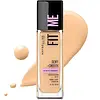What's inside
What's inside
 Key Ingredients
Key Ingredients

 Benefits
Benefits

 Concerns
Concerns

 Ingredients Side-by-side
Ingredients Side-by-side

Ethylhexyl Methoxycinnamate 7%
UV AbsorberWater
Skin ConditioningCyclopentasiloxane
EmollientDimethicone
EmollientGlycerin
HumectantIsotridecyl Isononanoate
EmollientPEG-9 Polydimethylsiloxyethyl Dimethicone
EmulsifyingDisteardimonium Hectorite
StabilisingDimethicone/Polyglycerin-3 Crosspolymer
CleansingSodium Chloride
MaskingPEG-10 Dimethicone
Skin ConditioningPhenoxyethanol
PreservativeMethylparaben
PreservativeDisodium Stearoyl Glutamate
CleansingChlorphenesin
AntimicrobialDisodium EDTA
EDTA
Acrylates Copolymer
Propylparaben
PreservativeParfum
MaskingTocopherol
AntioxidantAscorbyl Palmitate
AntioxidantAluminum Hydroxide
EmollientButylparaben
MaskingPEG-9
HumectantEthylparaben
PreservativeDipropylene Glycol
HumectantAlpha-Isomethyl Ionone
PerfumingTitanium Dioxide
Cosmetic ColorantIron Oxides
Ethylhexyl Methoxycinnamate 7%, Water, Cyclopentasiloxane, Dimethicone, Glycerin, Isotridecyl Isononanoate, PEG-9 Polydimethylsiloxyethyl Dimethicone, Disteardimonium Hectorite, Dimethicone/Polyglycerin-3 Crosspolymer, Sodium Chloride, PEG-10 Dimethicone, Phenoxyethanol, Methylparaben, Disodium Stearoyl Glutamate, Chlorphenesin, Disodium EDTA, EDTA, Acrylates Copolymer, Propylparaben, Parfum, Tocopherol, Ascorbyl Palmitate, Aluminum Hydroxide, Butylparaben, PEG-9, Ethylparaben, Dipropylene Glycol, Alpha-Isomethyl Ionone, Titanium Dioxide, Iron Oxides
Water
Skin ConditioningDimethicone
EmollientCoco-Caprylate/Caprate
EmollientTrimethylsiloxysilicate
EmollientPhenyl Trimethicone
Skin ConditioningCetyl PEG/PPG-10/1 Dimethicone
EmulsifyingPropanediol
SolventPolyglyceryl-4 Isostearate
EmulsifyingGlycerin
HumectantMica
Cosmetic ColorantSodium Hyaluronate
HumectantRhododendron Ferrugineum Extract
MaskingCocos Nucifera Fruit Juice
EmollientTocopheryl Acetate
AntioxidantCaprylyl Glycol
EmollientMethicone
EmollientCocos Nucifera Oil
MaskingDisteardimonium Hectorite
StabilisingSodium Chloride
Masking1,2-Hexanediol
Skin ConditioningTrisodium Ethylenediamine Disuccinate
Sodium Dehydroacetate
PreservativeSodium Benzoate
MaskingPotassium Sorbate
PreservativeCI 77891
Cosmetic ColorantCI 77491
Cosmetic ColorantCI 77492
Cosmetic ColorantCI 77499
Cosmetic ColorantWater, Dimethicone, Coco-Caprylate/Caprate, Trimethylsiloxysilicate, Phenyl Trimethicone, Cetyl PEG/PPG-10/1 Dimethicone, Propanediol, Polyglyceryl-4 Isostearate, Glycerin, Mica, Sodium Hyaluronate, Rhododendron Ferrugineum Extract, Cocos Nucifera Fruit Juice, Tocopheryl Acetate, Caprylyl Glycol, Methicone, Cocos Nucifera Oil, Disteardimonium Hectorite, Sodium Chloride, 1,2-Hexanediol, Trisodium Ethylenediamine Disuccinate, Sodium Dehydroacetate, Sodium Benzoate, Potassium Sorbate, CI 77891, CI 77491, CI 77492, CI 77499
Ingredients Explained
These ingredients are found in both products.
Ingredients higher up in an ingredient list are typically present in a larger amount.
Dimethicone is a type of synthetic silicone created from natural materials such as quartz.
What it does:
Dimethicone comes in different viscosities:
Depending on the viscosity, dimethicone has different properties.
Ingredients lists don't always show which type is used, so we recommend reaching out to the brand if you have questions about the viscosity.
This ingredient is unlikely to cause irritation because it does not get absorbed into skin. However, people with silicone allergies should be careful about using this ingredient.
Note: Dimethicone may contribute to pilling. This is because it is not oil or water soluble, so pilling may occur when layered with products. When mixed with heavy oils in a formula, the outcome is also quite greasy.
Learn more about DimethiconeDisteardimonium Hectorite comes from the clay mineral named hectorite. It is used to add thickness to a product.
It can also help stabilize a product by helping to disperse other ingredients.
Hectorite is a rare, white clay mineral.
Learn more about Disteardimonium HectoriteGlycerin is already naturally found in your skin. It helps moisturize and protect your skin.
A study from 2016 found glycerin to be more effective as a humectant than AHAs and hyaluronic acid.
As a humectant, it helps the skin stay hydrated by pulling moisture to your skin. The low molecular weight of glycerin allows it to pull moisture into the deeper layers of your skin.
Hydrated skin improves your skin barrier; Your skin barrier helps protect against irritants and bacteria.
Glycerin has also been found to have antimicrobial and antiviral properties. Due to these properties, glycerin is often used in wound and burn treatments.
In cosmetics, glycerin is usually derived from plants such as soybean or palm. However, it can also be sourced from animals, such as tallow or animal fat.
This ingredient is organic, colorless, odorless, and non-toxic.
Glycerin is the name for this ingredient in American English. British English uses Glycerol/Glycerine.
Learn more about GlycerinChances are, you eat sodium chloride every day. Sodium Chloride is also known as table salt.
This ingredient has many purposes in skincare: thickener, emulsifier, and exfoliator.
You'll most likely find this ingredient in cleansers where it is used to create a gel-like texture. As an emulsifier, it also prevents ingredients from separating.
There is much debate on whether this ingredient is comedogenic. The short answer - comedogenic ratings don't tell the whole story. Learn more about comegodenic ratings here.
The concensus about this ingredient causing acne seems to be divided. Research is needed to understand if this ingredient does cause acne.
Scrubs may use salt as the primary exfoliating ingredient.
Learn more about Sodium ChlorideWater. It's the most common cosmetic ingredient of all. You'll usually see it at the top of ingredient lists, meaning that it makes up the largest part of the product.
So why is it so popular? Water most often acts as a solvent - this means that it helps dissolve other ingredients into the formulation.
You'll also recognize water as that liquid we all need to stay alive. If you see this, drink a glass of water. Stay hydrated!
Learn more about Water